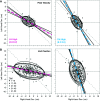Bilateral arm movements are coordinated via task-dependent negotiations between independent and codependent control, but not by a "coupling" control policy
- PMID: 37529832
- PMCID: PMC10655823
- DOI: 10.1152/jn.00501.2022
Bilateral arm movements are coordinated via task-dependent negotiations between independent and codependent control, but not by a "coupling" control policy
Abstract
Prior research has shown that coordination of bilateral arm movements might be attributed to either control policies that minimize performance and control costs regardless of bilateral symmetry or by control coupling, which activates bilaterally homologous muscles as a single unit to achieve symmetric performance. We hypothesize that independent bimanual control (movements of one arm are performed without influence on the other) and codependent bimanual control (two arms are constrained to move together with high spatiotemporal symmetry) are two extremes on a coordination spectrum that can be negotiated to meet infinite variations in task demands. To better understand and distinguish between these views, we designed a task where minimization of either control costs or asymmetry would yield different patterns of coordination. Participants made bilateral reaches with a shared visual cursor to a midline target. We then covertly varied the gain contribution of either hand to the shared cursor's horizontal position. Across two experiments, we show that bilateral coordination retains high task-dependent sensitivity to subtle visual feedback gain asymmetries applied to the shared cursor. Specifically, we found a change from strong spatial covariation between hands during equal gains to more independent control during asymmetric gains, which occurred rapidly and with high specificity to the dimension of gain manipulation. Furthermore, the extent of spatial covariation was graded to the magnitude of perpendicular gain asymmetry between hands. These findings suggest coordination of bilateral arm movements flexibly maneuvers along a continuous coordination spectrum in a task-dependent manner that cannot be explained by bilateral control coupling.NEW & NOTEWORTHY Minimization of performance and control costs and efferent coupling between bilaterally homologous muscle groups have been separately hypothesized to describe patterns of bimanual coordination. Here, we address whether the mechanisms mediating independent and codependent control between limbs can be weighted for successful task performance. Using bilaterally asymmetric visuomotor gain perturbations, we show bimanual coordination can be characterized as a negotiation along a spectrum between extremes of independent and codependent control, but not efferent control coupling.
Keywords: bimanual; coordination; reaching; vision.
Conflict of interest statement
No conflicts of interest, financial or otherwise, are declared by the authors.
Figures










Similar articles
-
Symmetry and synchrony of bimanual movements are not predicated on interlimb control coupling.J Neurophysiol. 2024 Jun 1;131(6):982-996. doi: 10.1152/jn.00476.2023. Epub 2024 Apr 17. J Neurophysiol. 2024. PMID: 38629153 Free PMC article.
-
Shared bimanual tasks elicit bimanual reflexes during movement.J Neurophysiol. 2009 Dec;102(6):3142-55. doi: 10.1152/jn.91335.2008. Epub 2009 Sep 30. J Neurophysiol. 2009. PMID: 19793874 Free PMC article.
-
The control of amplitude and direction in a bimanual coordination task.Hum Mov Sci. 2019 Jun;65:S0167-9457(17)30944-2. doi: 10.1016/j.humov.2018.03.014. Epub 2018 Mar 29. Hum Mov Sci. 2019. PMID: 29605439
-
How optimal is bimanual tracking? The key role of hand coordination in space.J Neurophysiol. 2020 Feb 1;123(2):511-521. doi: 10.1152/jn.00119.2019. Epub 2019 Nov 6. J Neurophysiol. 2020. PMID: 31693447
-
Inter-limb interference during bimanual adaptation to dynamic environments.Exp Brain Res. 2010 May;202(3):693-707. doi: 10.1007/s00221-010-2175-9. Epub 2010 Feb 20. Exp Brain Res. 2010. PMID: 20174919 Free PMC article.
Cited by
-
Symmetry and synchrony of bimanual movements are not predicated on interlimb control coupling.J Neurophysiol. 2024 Jun 1;131(6):982-996. doi: 10.1152/jn.00476.2023. Epub 2024 Apr 17. J Neurophysiol. 2024. PMID: 38629153 Free PMC article.
References
Publication types
MeSH terms
Grants and funding
LinkOut - more resources
Full Text Sources

